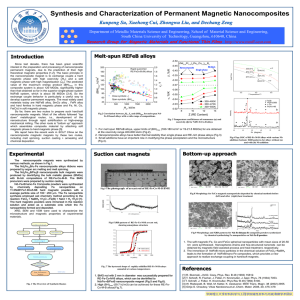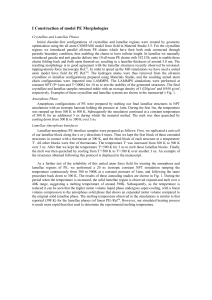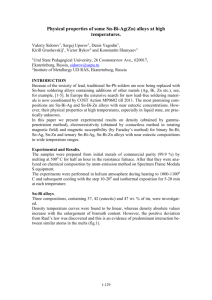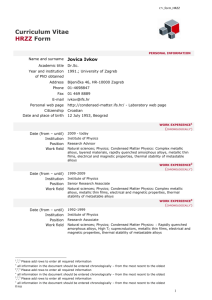Physical Properties of Al-Co
advertisement
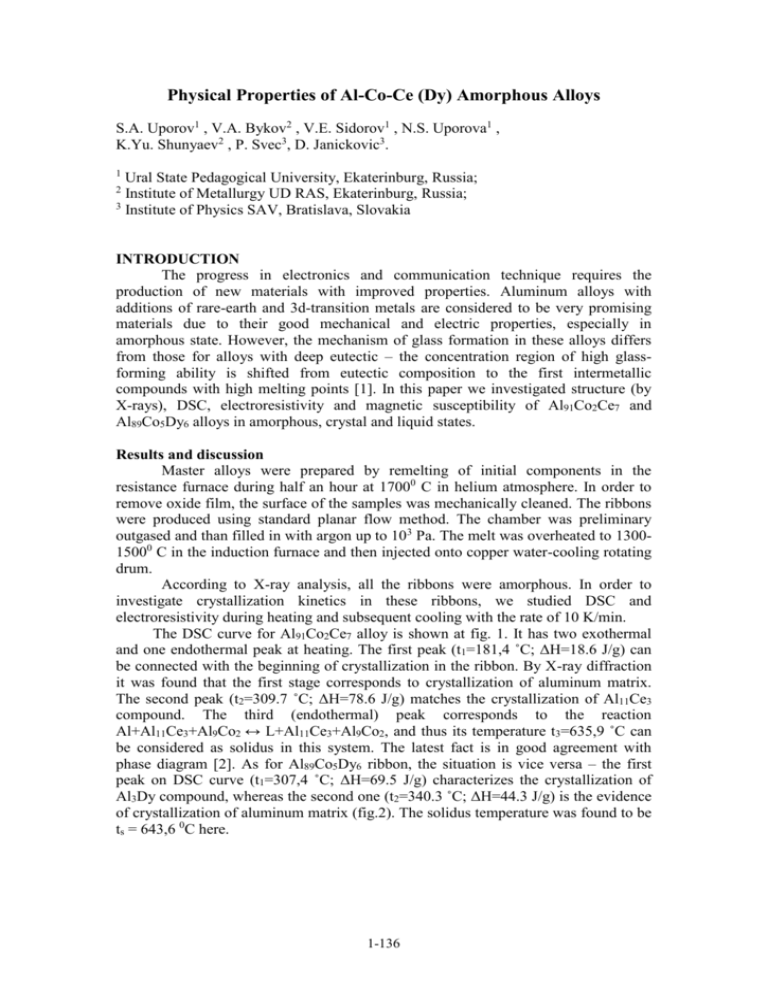
Physical Properties of Al-Co-Ce (Dy) Amorphous Alloys S.A. Uporov1 , V.A. Bykov2 , V.E. Sidorov1 , N.S. Uporova1 , K.Yu. Shunyaev2 , P. Svec3, D. Janickovic3. 1 Ural State Pedagogical University, Ekaterinburg, Russia; Institute of Metallurgy UD RAS, Ekaterinburg, Russia; 3 Institute of Physics SAV, Bratislava, Slovakia 2 INTRODUCTION The progress in electronics and communication technique requires the production of new materials with improved properties. Aluminum alloys with additions of rare-earth and 3d-transition metals are considered to be very promising materials due to their good mechanical and electric properties, especially in amorphous state. However, the mechanism of glass formation in these alloys differs from those for alloys with deep eutectic – the concentration region of high glassforming ability is shifted from eutectic composition to the first intermetallic compounds with high melting points [1]. In this paper we investigated structure (by X-rays), DSC, electroresistivity and magnetic susceptibility of Al91Co2Ce7 and Al89Co5Dy6 alloys in amorphous, crystal and liquid states. Results and discussion Master alloys were prepared by remelting of initial components in the resistance furnace during half an hour at 17000 C in helium atmosphere. In order to remove oxide film, the surface of the samples was mechanically cleaned. The ribbons were produced using standard planar flow method. The chamber was preliminary outgased and than filled in with argon up to 103 Pa. The melt was overheated to 130015000 C in the induction furnace and then injected onto copper water-cooling rotating drum. According to X-ray analysis, all the ribbons were amorphous. In order to investigate crystallization kinetics in these ribbons, we studied DSC and electroresistivity during heating and subsequent cooling with the rate of 10 K/min. The DSC curve for Al91Co2Ce7 alloy is shown at fig. 1. It has two exothermal and one endothermal peak at heating. The first peak (t1=181,4 ˚С; ΔH=18.6 J/g) can be connected with the beginning of crystallization in the ribbon. By X-ray diffraction it was found that the first stage corresponds to crystallization of aluminum matrix. The second peak (t2=309.7 ˚С; ΔH=78.6 J/g) matches the crystallization of Al11Ce3 compound. The third (endothermal) peak corresponds to the reaction Al+Al11Ce3+Al9Co2 ↔ L+Al11Ce3+Al9Co2, and thus its temperature t3=635,9 ˚С can be considered as solidus in this system. The latest fact is in good agreement with phase diagram [2]. As for Al89Co5Dy6 ribbon, the situation is vice versa – the first peak on DSC curve (t1=307,4 ˚С; ΔH=69.5 J/g) characterizes the crystallization of Al3Dy compound, whereas the second one (t2=340.3 ˚С; ΔH=44.3 J/g) is the evidence of crystallization of aluminum matrix (fig.2). The solidus temperature was found to be ts = 643,6 0С here. 1-136 Fig.1. Temperature dependent heat flow rate (DSC) for Al91Co2Ce7 alloy Fig.2. Temperature dependent heat flow rate (DSC) for Al89Co5Dy6 alloy Two stages of crystallization can be distinctly seen on electroresistivity temperature curves as well (fig. 3 and 4). In amorphous state resistivity practically does not depend on temperature, and remains for 20 % higher than in liquid state and for 80 % higher than in crystal. Magnetic susceptibility temperature and field dependences were studied for both ribbons. Susceptibility temperature curves χ(T) for amorphous Al91Co2Ce7 and Al89Co5Dy6 ribbons in comparison with crystalline analogues are presented at fig. 5 and 6. It was obtained that in amorphous state magnetic susceptibility decreases follow Curie-Weiss law; no anomalies at the beginning of crystallization were fixed. However, the pronounced field dependence of susceptibility was stated for both ribbons. In crystal and liquid state the results are practically the same as for nonquenched samples, no hysteresis of property was found out. In order to compare parameters of electronic structure in amorphous and crystalline state, the experimental susceptibility curves were fitted by generalized Curie-Weiss law using less-square method 1-137 Fig. 3. Relative electroresistivity vs temperature for Al-Co-Ce ribbon Fig. 4. Relative electroresistivity vs temperature for Al-Co-Dy ribbon p (T ) 0 C , (1) T here C is Curie constant, Θ - paramagnetic Curie temperature and χ0 - the temperature independent susceptibility depending mainly on density of electron states at the Fermi level. 1-138 Fig.5. Magnetic susceptibility temperature curves for Al91Co2Ce7 alloy: ○,● – amorphous; ∆,▲ – crystalline; ∆,○ – heating; ●,▲ – cooling 5 .10 , эме/г 7 5 3 1 0 300 600 900 1200 0 t, С 1500 Fig.6. Magnetic susceptibility temperature curves for Al89Co5Dy6 alloy: ○,● – amorphous; ∆,▲ – crystalline; ∆,○ – heating; ●,▲ – cooling, Density of states at Fermi level N(EF) can be derived from temperature independent term χ0 using eq. (2) χ 0 2N A M 1 μ Б N(E F )ξ , 1-139 (2) here NA – Avogadro number, M – molar mass, ξ – exchange amplification factor (for rare earth metals ξ = 1.5 [3-5]). Thus aluminum is a very weak paramagnetic material and cobalt atoms exist here in nonmagnetic state [6], the effective magnetic moment per rare earth atom was calculated using μ eff 3kC(M 1 M 2 ) , αN A (μ Б ) 2 (3) here k – Boltsman constant, µB – Bohr magneton, М1, М2 ,α ,β – molar masses and atomic fractions of REM and aluminum respectively. The results of calculations are given in table 1. Table 1. Parameters of electronic structure Al91Co2Ce7 Al89Co5Dy6 amorphous. crystalline amorphous. crystalline 0·106, emu/g N(EF), eV-1 , К C·105, emu*K/g eff, B 1.484 1.490 6.929 6.915 0.545 5 0.545 98 1.928 108 1.925 70 58.75 74.19 1419.06 1455.11 0.97 1.09 5.545 5.615 Amorphous state can be considered, in first approximation, as frozen liquid. Thus the values of electronic parameters, obtained for amorphous state, can be transferred to liquid state as well. The effective magnetic moments and densities of states at Fermi level are practically the same in crystal and amorphous states. The essential difference was fixed for paramagnetic temperature only. It can be connected either with the changes in magnetic environment of rare earth atoms, or with the difference in interatomic distances in crystalline and amorphous phases. Amorphous ribbons are characterized by the field dependence of magnetic susceptibility. This fact demonstrates superparamagnetic behavior of susceptibility. Thus, the structure of the samples can be represented as paramagnetic aluminum matrix with the inclusions of microparticles consisting of AlxREMy and AlxTMy quasymolecules. These microparticles are characterized by specific magnetic ordering, and the total susceptibility of the alloys can be approximated by [3]: (T , B) NM 02 M 0 B f p (T ) , (4) 4kT kT In eq. (4) N is the number of particles per mass unit and Mo is the average magnetic moment of one particle. The first term corresponds to superparamagnetic particles and the second describes the susceptibility of the remaining paramagnetic matrix. The “generalized” Curie-Weiss law can be used for the second term as it was done above. Fitting experimental χ(B) curves by eq. (4), one can get parameters for superparamagnetic particles. For Al91Co2Ce7 alloy the following results were obtained: the average magnetic moment per superparamagnetic particle Mo = 2165 µB, the mass density of these particles N ≅ 1.9·1015 g-1. For Al89Co5Dy6: Mo = 4040 µB, N ≅ 1.45·1015 g-1 respectively. The obtained values N = (1.45÷1.9)·1015 g-1 seem to be 1-140 very small and that is why such superparamagnetic particles can not be registered using standard X-ray diffraction method. Taking into account that effective magnetic moments per rare earth atom in Al2Ce and Al11Ce3 compounds are µef ≅2.5 µB and µef ≅1.1 µB, and in Al2Dy and Al3Dy compounds - µef ≅9.5 µB and µef ≅5.6 µB respectively, using equation Mo = n * μeff, one can estimate n - the effective number of “noncompensated” magnetic moments in the particle. For the ribbon Al91Co2Ce7 the results are: n1(µef ≅2.5 µB) = 870 and n2(µef ≅1.1 µB) = 1970, as for Al89Co5Dy6 ribbon - n1(µef ≅5.6 µB) = 425 and n2(µef ≅9.5 µB) = 720 respectively. The obtained n values demonstrate the fact that superparamagnetic particles consist of a large number of atoms (molecules). It becomes possible to suppose that these superparamagnetic particles do not appear during quenching the melt, but exist in liquid state even at high overheating above liquidus. This fact is necessary to take into account while creating a model of liquid alloys with tendency to amorphization. Conclusions The obtained values of electronic parameters for Al-Сo-Ce and Al-Co-Dy alloys in crystalline and amorphous states allow us to make the following conclusions: the effective magnetic moments per cerium (1.1 µB) or dysprosium (5.6 µB) atoms are the evidence of the fact that in investigated alloys rare earth atoms exist not in R3+ state, as it was considered before [4], but create directed bonds with aluminum atoms (this idea was generated in our previous papers [7,8]). This situation takes place in amorphous, crystalline and liquid states. 4felectrons located earlier on REM ions are involved now into directed bonds formation, i.e. some part of them become delocalized. Because of that effective magnetic moment on REM atom decreases and becomes lower than for R3+ ion. We think that in Al-Co-Ce(Dy) alloys the probability of Al2Ce (Al2Dy) quasymolecules existence is rather high; density of electron states at Fermi level has small values in Al-Co-Ce(Dy) alloys independently on state (amorphous, crystal or liquid). It means that 4fand 3d-zones do not overlap and have maximums rather far from Fermi level. The work is supported by RFBR (grants N 07-02-01049 and N 09-03-90450) and Federal Target Program (Contract П895) References 1. Battezzati L., Ambrosio E., Rizzi P. et al. Сomplex transformation sequences in Al-TM-RE amorphous alloys. - In: Proceedings of the 22nd Riso International Symposium on Materials Science: Science of Metastable and Nanocrystalline Alloys Structure, Properties and Modelling, Roskilde, Denmark, 2001, p. 211-216. 2. P. Villars, A. Prince, and H. Okamoto: Handbook of Ternary Alloy Phase Diagrams, ASM INTERNATIONAL, Materials Park, OH, 1995. 3. S.V. Vonsovsky. Magnetism // М., Nauka, 1971, 1024 с. 4. Taylor K. Physics of Rare Earth Solids // Adv. Phys., 1971, v. 20, p. 551-558. 5. Buschow K. Intermetallic compounds of rare earths and non-magnetic metals // Rep. Prog. Phys., 1979, v. 42, p. 1373-1477. 1-141 6. S. A. Uporov, N. S. Uporova, V. E. Sidorov, and K. Yu. Shunyaev, Magnetic Susceptibility of Al–Co–R (R = Ce, Dy) Vitrifying Alloys at High Temperatures // High Temperature, 2010, Vol. 48, No. 4, pp. 497–505. 7. Sidorov V. E., Gornov O. A., Bykov. V. A. et al., Magnetic studies of intermetallic compounds Al3R (Al11R3) both in the solid and liquid states. - J. of Non Crys. Sol. 2007, V. 353(32-40), p. 3094-3098. 8. Sidorov V., Gornov O., Bykov V. et al. Physical properties of Al–R melts. Mat. Sci. Eng. A, 2007, V. 449-451, p. 586-589. 1-142

